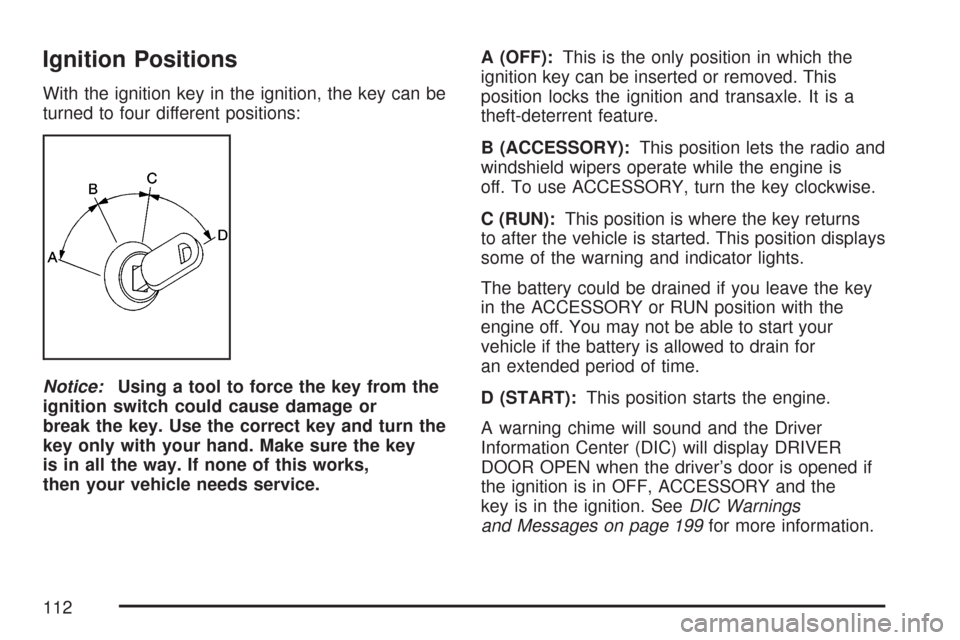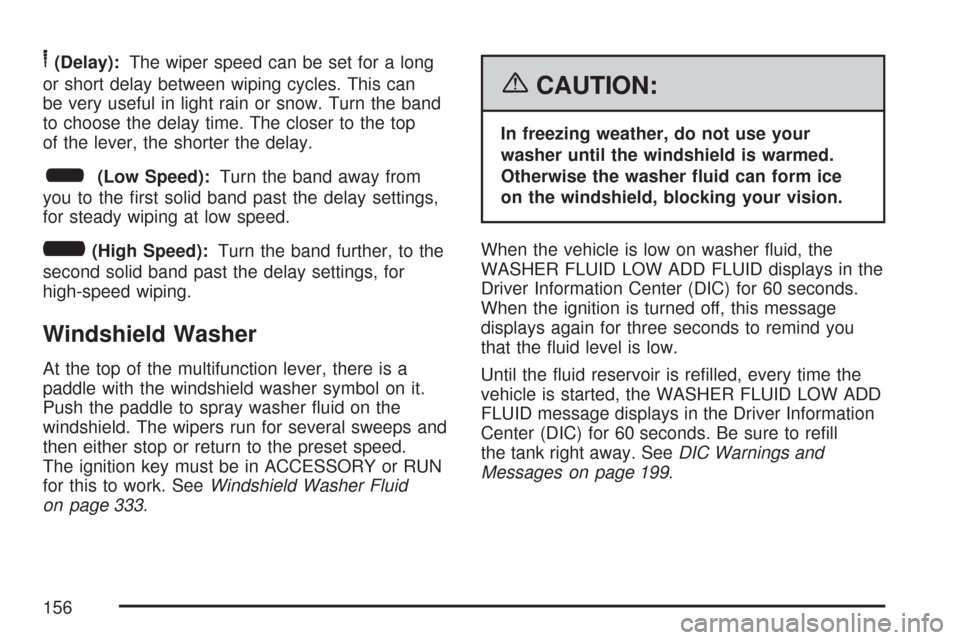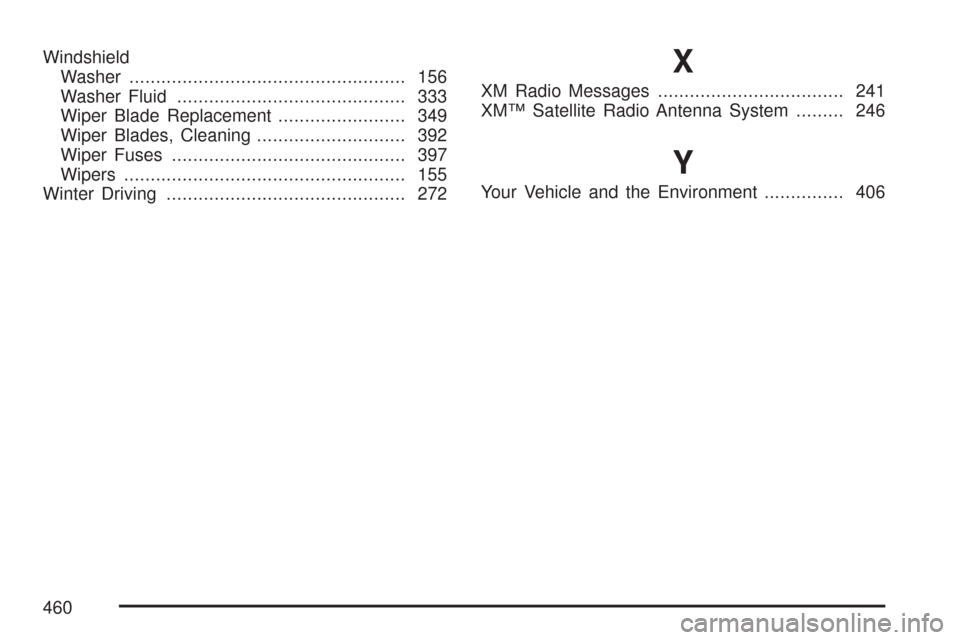2007 CHEVROLET IMPALA wipers
[x] Cancel search: wipersPage 112 of 460

Ignition Positions
With the ignition key in the ignition, the key can be
turned to four different positions:
Notice:Using a tool to force the key from the
ignition switch could cause damage or
break the key. Use the correct key and turn the
key only with your hand. Make sure the key
is in all the way. If none of this works,
then your vehicle needs service.A (OFF):This is the only position in which the
ignition key can be inserted or removed. This
position locks the ignition and transaxle. It is a
theft-deterrent feature.
B (ACCESSORY):This position lets the radio and
windshield wipers operate while the engine is
off. To use ACCESSORY, turn the key clockwise.
C (RUN):This position is where the key returns
to after the vehicle is started. This position displays
some of the warning and indicator lights.
The battery could be drained if you leave the key
in the ACCESSORY or RUN position with the
engine off. You may not be able to start your
vehicle if the battery is allowed to drain for
an extended period of time.
D (START):This position starts the engine.
A warning chime will sound and the Driver
Information Center (DIC) will display DRIVER
DOOR OPEN when the driver’s door is opened if
the ignition is in OFF, ACCESSORY and the
key is in the ignition. SeeDIC Warnings
and Messages on page 199for more information.
112
Page 147 of 460

Instrument Panel Overview........................ 150
Hazard Warning Flashers.......................... 152
Other Warning Devices............................. 152
Horn.......................................................... 152
Tilt Wheel.................................................. 153
Turn Signal/Multifunction Lever.................. 153
Turn and Lane-Change Signals................. 154
Headlamp High/Low-Beam Changer.......... 155
Flash-to-Pass............................................ 155
Windshield Wipers..................................... 155
Windshield Washer.................................... 156
Cruise Control........................................... 157
Exterior Lamps.......................................... 160
Delayed Headlamps.................................. 162
Daytime Running Lamps (DRL)/
Automatic Headlamp System.................. 162
Fog Lamps................................................ 163
Instrument Panel Brightness...................... 163
Courtesy Lamps........................................ 163
Dome Lamp.............................................. 164
Entry Lighting............................................ 164
Delayed Entry Lighting.............................. 164
Delayed Exit Lighting................................. 165
Parade Dimming........................................ 165
Reading Lamps......................................... 165Electric Power Management...................... 165
Battery Run-Down Protection..................... 166
Accessory Power Outlet(s)........................ 167
Ashtray(s) and Cigarette Lighter................ 168
Climate Controls......................................... 168
Climate Control System............................. 168
Outlet Adjustment...................................... 172
Passenger Compartment Air Filter............. 173
Warning Lights, Gages, and Indicators..... 174
Instrument Panel Cluster........................... 175
Speedometer and Odometer...................... 176
Tachometer............................................... 176
Safety Belt Reminder Light........................ 177
Passenger Safety Belt Reminder Light....... 177
Airbag Readiness Light............................. 178
Passenger Airbag Status Indicator............. 179
Charging System Light.............................. 181
Brake System Warning Light..................... 181
Anti-Lock Brake System Warning Light...... 182
Traction Control System (TCS)
Warning Light........................................ 183
Engine Coolant Temperature
Warning Light........................................ 183
Engine Coolant Temperature Gage............ 184
Section 3 Instrument Panel
147
Page 153 of 460

Tilt Wheel
A tilt wheel allows you to adjust the steering wheel
before you drive. The steering wheel can be
raised to the highest level to give your legs more
room when you enter and exit the vehicle.
The tilt wheel lever is located on the left side of
the steering column.
To tilt the wheel, hold the wheel and pull the lever.
Then move the wheel to a comfortable position
and release the lever to lock the wheel in place.
Turn Signal/Multifunction Lever
The lever on the left side of the steering column
includes the following:
GTurn and Lane Change Signals. See
Turn and Lane-Change Signals on page 154.
2Headlamp High/Low-Beam Changer.
SeeHeadlamp High/Low-Beam Changer on
page 155.
Flash-to-Pass. SeeFlash-to-Pass on page 155.
NWindshield Wipers. SeeWindshield Wipers
on page 155.
LQWindshield Washer. SeeWindshield
Washer on page 156.
For information on the headlamps, seeExterior
Lamps on page 160.
153
Page 155 of 460

Headlamp High/Low-Beam Changer
To change the headlamps from low beam to
high beam, push the turn signal/multifunction lever
toward the front of the vehicle.
This light on the
instrument panel
cluster comes on if
the high beam lamps
are turned on while
the ignition is on.
To change the headlamps from high beam to low
beam, pull the turn signal lever toward the rear
of the vehicle.
Flash-to-Pass
With the turn signal lever in the low-beam position,
pull the lever toward you momentarily to switch
to high-beam (to signal that you are going to pass).
If the headlamps are on, they will return to
low-beam when the lever is released.
This feature operates even when the headlamps
are off.
Windshield Wipers
Be sure to clear ice and snow from the wiper
blades before using them. If they are frozen to the
windshield, gently loosen or thaw them. Damaged
wiper blades may not clear the windshield well,
making it harder to see and drive safely. If the
blades do become damaged, install new blades or
blade inserts. For more information, seeWindshield
Wiper Blade Replacement on page 349.
Heavy snow or ice can overload the wiper motor.
A circuit breaker will stop the motor until it
cools down. Clear away snow or ice to prevent
an overload.
The windshield wipers are controlled by turning
the band with the wiper symbol.
8(Mist):Turn the band to mist for a single
wiping cycle. Hold it there until the wipers start.
Then let go. The wipers will stop after one wipe.
Hold the band on mist longer, for more wipe cycles.
9(Off):To stop the wipers, move the band
to off.
155
Page 156 of 460

6(Delay):The wiper speed can be set for a long
or short delay between wiping cycles. This can
be very useful in light rain or snow. Turn the band
to choose the delay time. The closer to the top
of the lever, the shorter the delay.
6(Low Speed):Turn the band away from
you to the �rst solid band past the delay settings,
for steady wiping at low speed.
?(High Speed):Turn the band further, to the
second solid band past the delay settings, for
high-speed wiping.
Windshield Washer
At the top of the multifunction lever, there is a
paddle with the windshield washer symbol on it.
Push the paddle to spray washer �uid on the
windshield. The wipers run for several sweeps and
then either stop or return to the preset speed.
The ignition key must be in ACCESSORY or RUN
for this to work. SeeWindshield Washer Fluid
on page 333.
{CAUTION:
In freezing weather, do not use your
washer until the windshield is warmed.
Otherwise the washer �uid can form ice
on the windshield, blocking your vision.
When the vehicle is low on washer �uid, the
WASHER FLUID LOW ADD FLUID displays in the
Driver Information Center (DIC) for 60 seconds.
When the ignition is turned off, this message
displays again for three seconds to remind you
that the �uid level is low.
Until the �uid reservoir is re�lled, every time the
vehicle is started, the WASHER FLUID LOW ADD
FLUID message displays in the Driver Information
Center (DIC) for 60 seconds. Be sure to re�ll
the tank right away. SeeDIC Warnings and
Messages on page 199.
156
Page 173 of 460

Passenger Compartment Air Filter
This vehicle has a passenger compartment
particulate air �lter. It is located underneath the
hood just below the windshield wiper arm on
the passenger’s side of the vehicle, under the air
inlet grille.
The �lter traps most of the pollen from air entering
the Climate Control System. Like your engine’s
air cleaner/�lter, it may need to be changed
periodically to ensure system performance. For
information on how often to change the passenger
compartment air �lter, seeScheduled Maintenance
on page 408.
To change the passenger compartment air �lter,
use the following steps:
1. Turn off the ignition when the windshield
wipers are in the up position.
2. Raise the vehicle hood.
3. Peel back the hood weatherstrip from the
passenger’s side of the vehicle halfway
to center.4. Remove the air inlet grille retainers.
5. Lift the air inlet grille and disconnect the
washer hose at the quick-connect.
6. Remove the air inlet grille.
7. Remove the water de�ector plate.
8. Remove the old passenger compartment
air �lter.
9. Reverse the steps to install the new air �lter.
For best climate control system performance,
be sure to re-install the air �lter.
For the type of �lter to use, seeNormal
Maintenance Replacement Parts on page 419.
173
Page 392 of 460

Windshield and Wiper Blades
Clean the outside of the windshield with glass
cleaner.
Clean the rubber blades using a lint free cloth or
paper towel soaked with windshield washer �uid or
a mild detergent. Wash the windshield thoroughly
when cleaning the blades. Bugs, road grime,
sap, and a buildup of vehicle wash/wax treatments
may cause wiper streaking. Replace the wiper
blades if they are worn or damaged.
Wipers can be damaged by:
Extreme dusty conditions
Sand and salt
Heat and sun
Snow and ice, without proper removal
Aluminum Wheels
Notice:If you use strong soaps, chemicals,
abrasive polishes, cleaners, brushes, or
cleaners that contain acid on aluminum or
chrome-plated wheels, you could damage the
surface of the wheel(s). The repairs would
not be covered by your warranty. Use
only approved cleaners on aluminum or
chrome-plated wheels.
Keep the wheels clean using a soft clean cloth
with mild soap and water. Rinse with clean water.
After rinsing thoroughly, dry with a soft clean
towel. A wax may then be applied.
Notice:Using chrome polish on aluminum
wheels could damage the wheels. The repairs
would not be covered by your warranty.
Use chrome polish on chrome wheels only.
392
Page 460 of 460

Windshield
Washer.................................................... 156
Washer Fluid........................................... 333
Wiper Blade Replacement........................ 349
Wiper Blades, Cleaning............................ 392
Wiper Fuses............................................ 397
Wipers..................................................... 155
Winter Driving............................................. 272X
XM Radio Messages................................... 241
XM™ Satellite Radio Antenna System......... 246
Y
Your Vehicle and the Environment............... 406
460